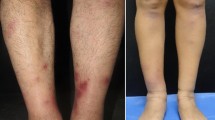Summary
Historically, arthritis was the main symptom which led to the description of the disease called Lyme borreliosis. However, a relatively high awareness of doctors and patients of tick-borne diseases seems to cause a trend to frequently diagnose this antibiotic-sensitive disease. A case can be defined as borreliosis only if either the typical erythema migrans is reliably identified by a physician or if a characteristic late manifestation of Lyme disease is accompanied by unequivocal serological and/or bacteriological evidence ofBorrelia infection. Within the musculoskeletal system, the only reliably characteristic symptom is true synovitis, as defined by the palpable swelling of a joint. Mere joint pain or the subjective pain syndrome of fibromyalgia do not constitute a defining symptom for borreliosis. An evaluation of the frequency ofBorrelia-associated arthritis in our Viennese rheumatology outpatient clinic revealed only six well-defined cases among 1,673 subsequent referrals. Based on “serological” suspicion, the question had been asked about possible borreliosis in 87 of these patients. In order to avoid unnecessary anxiety about possible long-term complications of Lyme disease among (actually misdiagnosed) patients, the diagnosis of Lyme arthritis should only be made according to the stringent criteria mentioned above. The antibiotic treatment, which is given to many questionable cases of borreliosisex iuvantibus, although possibly of benefit to a few cases of otherwise undiagnosed reactive arthritis due to infections with microbes other thanBorrelia burgdorferi, has to be termed irrational.
Zusammenfassung
Gelenkschmerzen waren das führende Symptom bei der Erstbeschreibung der nunmehr als Lyme-Borreliose bezeichneten Erkrankung. Der hohe Bekanntheitsgrad von durch Zecken übertragenen Erkrankungen führt bei Ärzten und Patienten sehr oft dazu, diese mit Antibiotika behandelbare Erkrankung zu vermuten. Die Diagnose „gesicherte Borreliose“ erfordert entweder den ärztlichen Befund eines typischen Erythema migrans oder das Vorhandensein typischer Spätsymptome dieser Krankheit ergänzt durch den technischen Nachweis einer stattgehabten Infektion mit Borrelien. Im Bereich des Bewegungsapparates ist als einzig verläßliches Symptom eine echte, synovitische Gelenkschwellung, als Arthritis anzusehen. Das Bestehen von „weichteilrheumatischen“ Beschwerden bei Patienten mit Borrelienantikörpern ist nicht ausreichend für die diagnostische Sicherung einer Borreliose. Eine Auswertung der Häufigkeit einer gesicherten Borreliose an unserer universitären Rheumaambulanz ergab eine Fallzahl von sechs Patienten unter 1673 konsekutiven Neuzuweisungen, wobei in 87 Fällen die Zuweisungsdiagnose Borreliose aufgrund von Antikörperbestimmungen entstanden war. Um unnötige Ängste der Patienten im Hinblick auf die möglichen Spätfolgen einer (gar nicht gesicherten) Borreliose zu vermeiden, sollte diese Diagnose daher nur nach den oben erwähnten Kriterien gestellt werden. Dieex-iuvantibus-Verabreichung von Antibiotika in nur vermuteten Fällen von Borreliose ist zwar verständlich, muß aber, obwohl sie auch bei sonst unerkannten bakteriell verursachten Gelenksentzündungen heilsam sein könnte, als nicht rational bezeichnet werden.
Similar content being viewed by others
References
Steere, A. C. Current understanding of Lyme disease. Hosp. Practice 28 (1993) 37–44.
Steere, A. C., Taylor, E., McHugh, G. L., Logigian, E. L. The over-diagnosis of Lyme disease. JAMA 269 (1993) 1812–1816.
Kolstoe, H., Messner, R. P. Lyme disease: musculoskeletal manifestations. Rheum. Dis. Clin. North Am. 15 (1989) 649–656.
Steere, A. C., Malawista, S. E., Snydman, D. R. Lyme arthritis: an epidemic of oligoarticular arthritis in children and adults in three Connecticut communities. Arthritis Rheum. 20 (1977) 7–17.
Steere, A. C., Schoen, R. T., Taylor, E. The clinical evolution of Lyme arthritis. Ann. Int. Med. 107 (1987) 725–731.
Huaux, J. P., Bigaignon, G., Stadtsbaeder, S., Zangerle, P. F., Nagant de Deuxchaisnes, C. Pattern of Lyme arthritis in Europe: report of 14 cases. Ann. Rheum. Dis. 47 (1988) 164–165.
Sigal, L. H. Persisting complaints attributed to chronic Lyme disease: possible mechanisms and implications for management. Am. J. Med. 96 (1994) 365–374.
Lauhio, A., Leirisalo-Repo, M., Lähdevirta, J., Saikku, P., Repo, H. Double-blind, placebo controlled study of three-month treatment with lymecycline in reactive arthritis, with special reference to Chlamydia arthritis. Arthr. Rheum. 34 (1991) 6–15.
Kalish, R. Lyme disease. Rheum. Dis. Clin. North Am. 19 (1993) 399–426.
Author information
Authors and Affiliations
Rights and permissions
About this article
Cite this article
Graninger, W. Behandlung der Lyme-Arthritis. Infection 24, 95–97 (1996). https://doi.org/10.1007/BF01780669
Issue Date:
DOI: https://doi.org/10.1007/BF01780669




